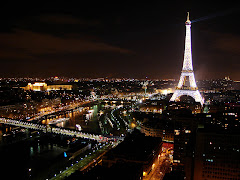
Move over San Francisco and New Orleans!
Needless to say, there are wonderful gay pride events to be found all over the globe, such as the exciting parades in the abovementioned cities. That being said, Paris' Gay Pride Parade and Festival combines the joy of being in Paris with a wonderful celebration of love itself, without distinction to gender.
Each summer, the Paris Gay Pride Parade an Festival rolls into town, most often toward the end-of-June. Although Paris’ “gay quarter” (and popular tourist haven in general) Le Marais springs first to mind, really this is but one of the many wonderful areas visitors should consider who plan to attend the festival.
MyKeystoParis.com offers a marvelous selection of apartments in Paris, not only in the Marais, but beautiful adjacent and nearby areas such as furnished apartments in the Latin Quarter, 1st, 2nd, 9th (Opera district), and many others.
The route of the parade varies, often beginning in the general vicinity of Montparnasse (14th) or Republique (3rd, 10th) and ending around the Beaubourg (3rd) or Bastille (11th). (Please check the latest news for the details of the upcoming parade, but please note often the exact route is not announced until the last minute.)
So in terms of lodging, you may also want to consider looking for something in the 14th on the Left Bank, the 11th on the Right Bank, or anywhere else landing close to the route. But be aware Paris is rather geographically small, so almost anywhere central won’t be more than a short walk or metro ride to the fun! (Needless to say, the 1st, 2nd, 3rd, 4th, 5th, 9th ,10th and 11th are probably your best bets, being in or near the gay quarter.)
Of course, there are many events leading up to the parade itself, such as festive and flamboyant balls, usually beginning a week or more before the day itself.
The “Marche des fiertés lesbiennes, gaies, bi & trans” itself is huge, each year brining an estimated 500,000+ people to the city. Think of this as Paris’ gay and festive “Mardi Gras,” with people dressed in elaborate costumes (and “dressed down” in body paint), alongside colorful floats.
If you’ve been to a gay pride event before, nothing will come as much of a shock to you. However, be aware that Paris has a relaxed view of sexuality, even by the standards of liberal cities like New Orleans or San Francisco, so expect a lot of good-natured, outrageous fun, and caveat to anyone who may feel put off by the uproarious celebrations. Expect miles of balloons, grinding dance music, whistles and costumes.
Paris has one of the largest gay and lesbian populations in Europe, attracted to Paris’ history of libertarian ideals and free-thinking. As such, the parade and festival have a more serious side, even though you may not see it on the surface: the festival is a potent reminder that discrimination still exists, and the necessity of equal rights for everyone, regardless of sexual nature. The festival calls for an end to hatred in the form of lesbophobia, homophobia and transphobia.
Clubbing is a big way to celebrate in the nights and days leading up to the parade. There are many great clubs in Paris, which can be found in a quick Google search for “gay clubs Paris”. Popular clubs like Le Club 18, Le Soir, and others have exciting events that include drink specials, and sometimes (but certainly not always) require tickets to be purchased in advance. If you don’t have a travel agent who specializes in gay travel, now may be the time to Google “gay travel agency.” Yes, they certainly do exist, and can help you plan your stay!
You may wish to take a look at the Lesbian, Gay, Bi and Trans site at http://cglparis.org/, but you’ll find it’s mostly in French at the current time.
But either way, expect to have a wonderful time in Paris during this exciting, meaningful festival.









